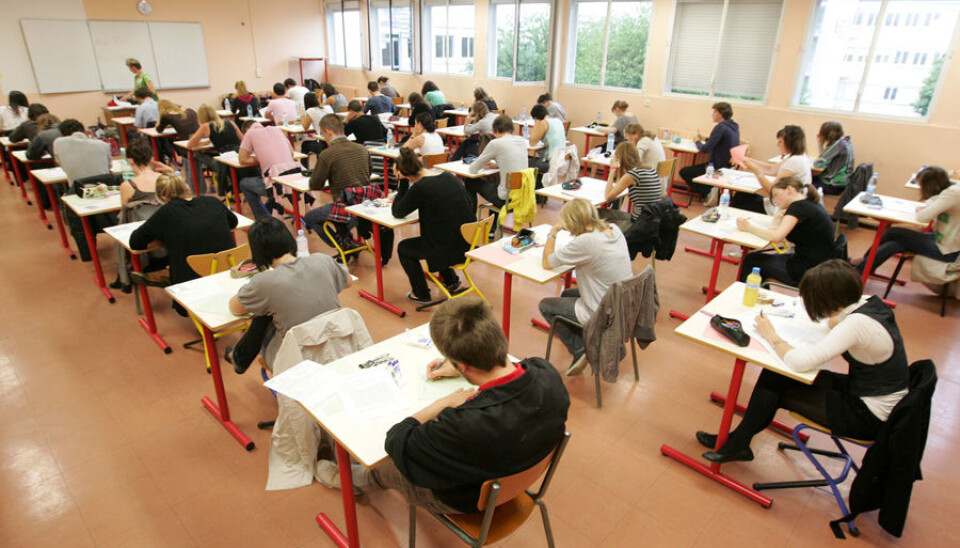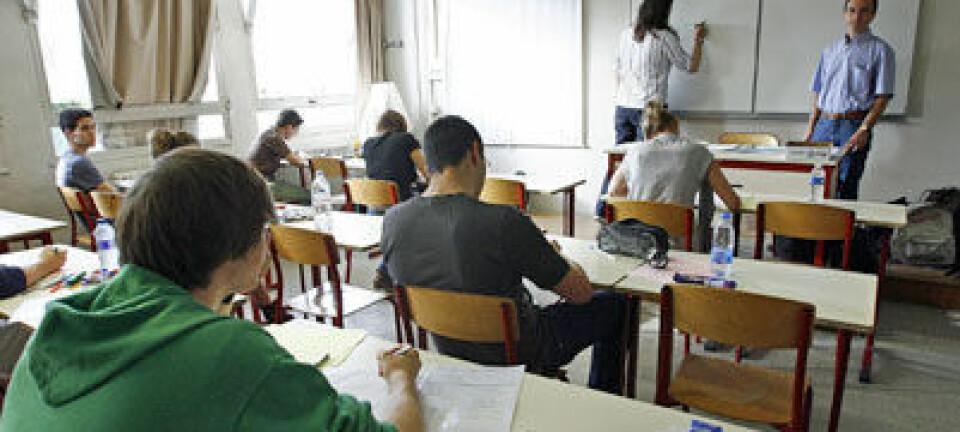This article was produced and financed by Oslo Metropolitan University

Children bear the brunt of open-plan schools
Despite their poor compliance with criteria for good learning, open-plan schools account for many of the school buildings recently built in Norway's largest cities. Researcher calls it a paradox.
Denne artikkelen er over ti år gammel og kan inneholde utdatert informasjon.
Many new schools in Norway are open-plan schools.
These schools are built on the basis of financial incentive in the hope of saving on building and operating costs and in an attempt to cope with growing pupil numbers within a given space, according to researcher Erlend Vinje.
"This is being done under the pretext of greater flexibility and more possibilities for adapted teaching, but the reality is often more noise, less concentration, and the practice of ability grouping that is pushing the limits of what is permissible under current regulations," he says
Vinje will soon complete his doctoral thesis in the form of five articles dealing with the prevalence of open-plan schools, discussed in the light of prevailing views on optimal conditions for learning
Challenging for the cities

According to Vinje, this situation particularly applies in Oslo, where the dramatic population growth and consequent pressure on student capacities are forcing school authorities and local politicians to look for solutions that can maximise tight and often shrinking budgets.
Space planning is their primary concern; as much available floor space as possible must be used for teaching activities and have a minimum of corridors.
"Through open learning spaces, architecture is becoming a lever that opens the door for a new type of pedagogy that has no basis in scientific research. It also conflicts with what teachers and parents believe provides optimal learning environments for children and adolescents," says Vinje.
Popular in the sixties
In Norway, open-plan schools gained popularity in the late 1960s and lasted for around fifteen years.
Although those schools are still in use, many municipalities decided to revert to classroom-based school buildings due to conflicts with teacher organisations and parents' committees. However, Oslo and – to some extent – Bergen chose to do the exact opposite.
According to calculations in 2011, nineteen new school buildings in Oslo were based on designs that could be categorised as open-plan.
And what is more, a number of existing schools at primary, lower, and upper secondary level are currently being converted into open-plan schools.
Research supports the classroom model
Research on criteria for good learning argues strongly in favour of the classroom model and of teacher-led organisation of instruction and student learning.
Vinje conducted surveys among teachers and studied media discourse on school buildings.
Eighty-one percent of the 1,700 teachers who responded to the survey favoured the traditional classroom environment.
When asked about their perception of being able to use qualitative methods to enhance learning, teachers from the traditional schools showed far higher levels of satisfaction than their colleagues in open-plan environments.
The media analysis, which included both editorial coverage and media debates, confirmed the impression that noise and disruption were often given as arguments by opponents of the open-plan model.
"In general, the critics of open-plan schools made more use of research findings to back up their arguments than their opponents," says Vinje.
Influenced by the Swedish school system
Erlend Vinje contends that the new wave of open-plan schools – though launched under more acceptable labels – can be traced back to Norwegian enthusiasm for Sweden's open-plan schools project "Skola 2000".
The vision for the project was to build a new category of school buildings combined with a new, more project-based system of school education. Proponents of the project envisioned low building costs and savings on operational costs of up to twenty percent compared with ordinary classroom-based alternatives.
Many key Norwegian school managers and owners apparently visited these new schools and were evidently fascinated by the possibilities they offered for cheaper solutions.
"Many school owners probably hope that the estimated twenty-per-cent savings on building and operating costs are realistic. However, the open-plan solutions that were launched in Norway had no pedagogical plan to support them. Teacher autonomy and the traditional method of class grouping were retained," says Vinje.
However, according to Vinje, this method of grouping is not conducive to space planning that is based on large open spaces surrounded by small rooms. Many teachers therefore compensate for what they perceive to be physically constrictive environments, with the result that as many as twenty-seven students can be squeezed into spaces that were originally designed for fifteen: "In many cases the large communal rooms end up not being used," says Vinje.
In Sweden the intention was to implement the project for open-plan schools nationwide, but it was eventually abandoned after negative experiences of increased noise and disturbance and a learning environment that had a particularly negative impact on the weaker students.
Disconcerting consequences
As part of his study, Vinje interviewed teachers working in both types of schools.
These interviews revealed different approaches to the principle of adapted education. In the classroom-based school, adapted education was mainly practised inside the classroom, while the open-plan school placed more emphasis on ability grouping and various types of achievement groups.
One of the teachers at the open-plan school described ability grouping as "the key to the open-plan school".
Vinje finds this disconcerting, because current regulations state that ability grouping should only be practised on a small scale. Nevertheless, an appeal lodged by a parent group at an open-plan school against what it perceived to be a permanent system of ability grouping was recently rejected by the Norwegian Directorate for Education and Training.
"This says something about the pressure that is being applied on the larger cities, which even politicians at national level are becoming increasingly aware of. We are witnessing the growth of a type of school in which much of the traditional class-based teaching model is being blatantly undermined under the pretext of greater flexibility," says Vinje.
"The findings of my research and that of others indicate that this is poorly aligned with desires to improve quality and to achieve a general improvement in school results."
----------------------
Read the Norwegian version of this article at forskning.no

































